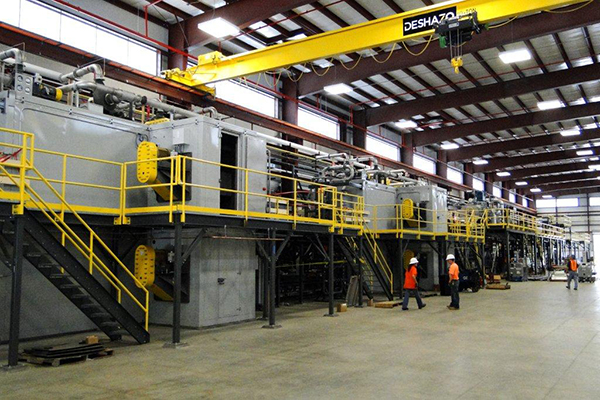ORNL Kicks off Clean Energy Initiative with New Carbon Fiber Facility
In his 2013 State of the Union Address, President Obama cited clean energy technology and advanced manufacturing as the foundation upon which the U.S. economy could be rebuilt.
 At the time, the spotlight fell on Youngstown, Ohio, where one of 15 planned manufacturing innovation institutes is underway, but this week the focus has shifted to Tennessee. There, one more brick of that economic groundwork was laid on Tuesday with the opening of Oak Ridge National Laboratory's Carbon Fiber Technology Facility (CFTF).
At the time, the spotlight fell on Youngstown, Ohio, where one of 15 planned manufacturing innovation institutes is underway, but this week the focus has shifted to Tennessee. There, one more brick of that economic groundwork was laid on Tuesday with the opening of Oak Ridge National Laboratory's Carbon Fiber Technology Facility (CFTF).
Officials from the DOE, ORNL, Ford Motor Company, and Dow Chemical were present as Assistant Secretary of Energy Dr. David Danielson performed the ribbon cutting. The facility is the product of President Obama's effort to revitalize the manufacturing sector, and has been designed to provide clean energy organizations a test bed for developing inexpensive, better performing carbon fiber materials.
The CFTF was awarded $34.7 million from the DOE's Vehicle Technologies Program in 2009 as a part of the American Recovery and Reinvestment Act. Once operations are in full-swing, it is expected to produce up to 25 tons of carbon fiber material per year.
The 42,000-square foot facility touts a 390-foot-long melt-spun fiber line for the testing of strong, lightweight fibers, among other “semi-production scale” equipment. The expectation is that materials developed here will then be transferred to the private sector where they can be manufactured at a cheaper cost. It has already attracted over 40 public and private sector partners, including Ford, Dow Chemical and Volkswagen of America.
Currently, carbon fiber is used almost exclusively in high-end specialty products, such as supercars, bicycles, golf clubs and even Boeing new 787 Dreamliner aircraft, because of its light weight and formidable tensile strength. But if this facility could help to lower the cost of carbon fiber, we could see its applications broaden to help improve the efficiency of wind turbines and a wider range of production cars, among others.
According to the DOE, implementing carbon-fiber composites could held to reduce the weight of a typical passenger car by 50 percent without hindering performance or affecting passenger safety. The Department estimated that such a dramatic weight reduction would improve fuel efficiency by about 35 percent.
This facility is but one part of Obama's Clean Energy Manufacturing Initiative (CEMI), which will expand upon the boost to carbon fiber by offering similar support for the manufacturing of wind turbines, solar panels, energy-efficient appliances, light bulbs, vehicles, and among other clean energy products.
Danielson noted in a written statement that a wide array of green technologies such as solar, wind, LEDs and biofuels “are within five to 10 years of being directly cost-competitive without subsidies.”
The initiative will also work to lower production costs for manufacturers across multiple industries by pushing for advancements in energy productivity. The DOE hopes that by implementing energy efficiency measures and taking advantage of energy sources such as natural gas will help make U.S. manufacturers lower their costs and become more competitive in the global market.
“We must seize this unique opportunity in time to ensure U.S. manufacturing competitiveness in the clean energy sector and take advantage of energy saving practices and low-cost domestic energy resources to advance the competitiveness of our manufacturing sector across the board,” said Danielson.
Other focuses of CEMI include geothermal technologies, battery development, providing energy productivity training and assistance to manufacturers, and hosting both regional and national summits to help unify the American manufacturing road map.
Making this possible is an integration of funding from sources across the DOE Office of Energy Efficiency and Renewable Energy (EERE) and the Advanced Manufacturing Office. But funding aside, the initiative is also planning to include federal agencies, research institutions and private sector partners.
While increased funding for clean energy manufacturing research, development and demonstration is a major component of the initiative, additional details, including funding amounts, will not be available until the president's Fiscal Year 2014 proposed budget is released.
But this isn't the last word on the funding front – according to DOE officials, a new funding opportunity for a Clean Energy Manufacturing Institute will soon be announced. Looking forward, the initiative will also analyze the clean energy manufacturing supply chain to inform future funding decisions from the Department.










